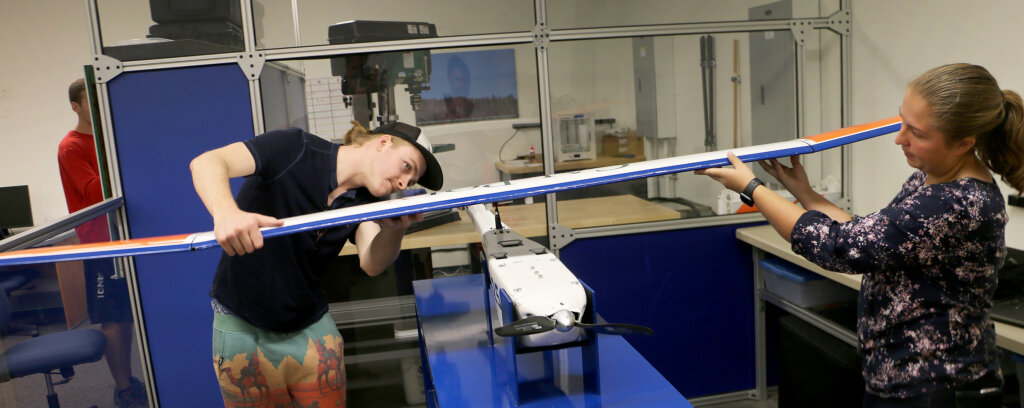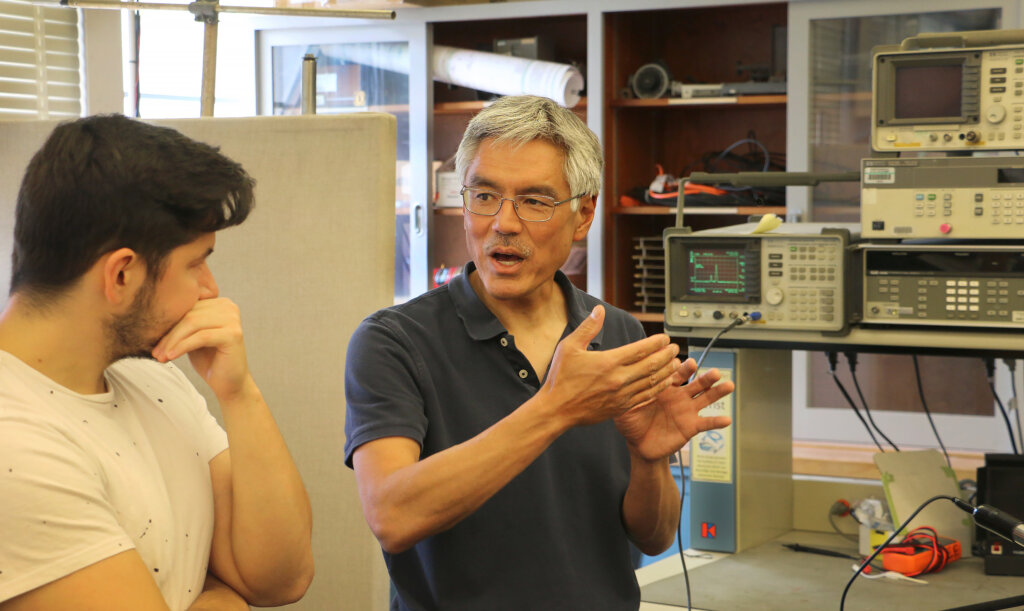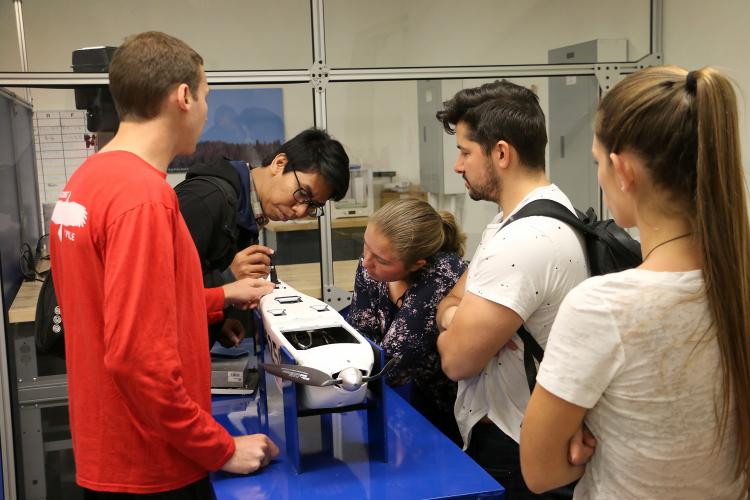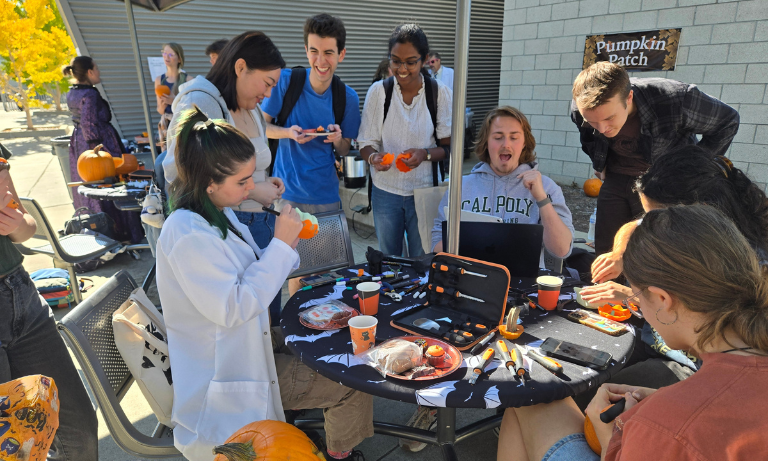Inspecting multiple drones parked in the Advanced Technology Lab, Dean Arakaki makes an important observation about tracking small mammals.
“We can’t use this one because it’s too loud,” says Arakaki, associate professor in the Electrical Engineering Department, sizing up a large helicopter unmanned aerial vehicle (UAV).
While the UAV would easily support the kind of antennas the U.S. Forest Service needs to study the tree-swelling carnivores called Pacific fishers, the aircraft’s loud propellers would surely scare the cat-sized critters off.
And that’s not natural.
“It sounds like the weed whacker from hell,” adds Marc Horney, noting the UAV’s noisy 2-cycle engine.

The two faculty members are assisting an interdisciplinary team of students tasked with using UAVs to gather location and movement information from the fishers in the Southern Sierra Nevada mountains. While the project aims to help the U.S. Forest Service gather data on the fisher, the technology, once proven, would also be useful for many other wildlife species, including mountain lions, and studies of free-ranging cattle, sheep, and horses.
The project, which brings together students from electrical engineering, aerospace engineering, mechanical engineering and animal science, originated last year when Horney, an associate professor in the Animal Science Department, visited the Forest Service’s San Joaquin Experimental Range research facility with staff and faculty from Cal Poly’s Swanton Pacific Ranch, and spent the day discussing collaborative research opportunities. Horney had been working with Dr. Aaron Drake in Aerospace Engineering for several years, using their UAVs for carrying research project payloads, and suggested that they might be an option for resolving some difficulties the Forest Service researchers had been having with tracking their fishers.
The long and skinny fisher, a member of the weasel family, was once abundant throughout Washington, Oregon and northern California. But the population declined in the 1800s due to the fur trade. Even after California banned fisher trapping in the 1940s, its population thinned due to logging, development and severe forest fires.
Considered a “sensitive” species, the U.S. Forest Service has used small collars fitted with GPS dataloggers and VHF beacon transmitters to monitor the furry creatures.
“For these animals, we don’t always know where they live, where they hang out, where they nest,” Horney said. “It is extremely difficult to follow these animals through miles of woodland, so the GPS is a convenient alternative. It can be programmed to automatically record the animals’ position at intervals all day long for weeks to months at a time.”
Miniaturizing GPS units and transmitters is just one of many challenges in tracking the fishers.
“Every time you trap and handle one of these animals, there’s a real risk of accidentally injuring them,” Horney said.
There are two main reasons why a marked animal would need to be recaptured, he added – to physically recover a data storage card or to replace batteries. With wireless systems in common use now, data recovery options typically entail using satellites, which is a better option for larger animals, or having someone on the ground, trying to follow VHF signal “pings” from handheld directional antennas and hoping to get close enough to trigger a data download.
Handheld directional antennas are routinely used by wildlife biologists for tracking marked animals, but it’s difficult to navigate the rugged terrain where the fishers live. That terrain also makes it dangerous for manned aircraft to fly over the area and get close enough to download the GPS data.
“Here is where there is an opportunity for UAVs,” Horney said.
Horney knew Drake and his students in the Unmanned Flight Initiative program could help develop UAVs. Then he contacted Arakaki about developing the antenna gear.
“The primary goals [with the antenna] is to not interfere with the flight dynamics,” Arakaki said.
The group recently met to discuss funding efforts – they’re applying for a Warren J. Baker Endowment — and travel plans. From there, they visited the drone lab, where it was quickly decided that they would use a fixed-wing UAV that resembles a plane.
“We’ve come up with three antennas that size-wise could pretty easily be installed on it directly,” said Chris Boone, a mechanical engineering major.

Arakaki and the electrical engineering students will have to determine the right amount of range and span for the antennas. Once that is decided, the unmanned aerial system will have two tasks related to the fishers, Arakaki said.
“It has to first detect where the collar is,” Arakaki said. “Once it gets a fix on where the collar is, they’re going to circle it for a little while – long enough to get the data.”
Even though the UAV will be able to download a month’s worth of data in less than a minute after getting close to the animal, the antenna handling that information can be very light, even a few ounces.
“What I’m going to have them look into is something called a patch antenna,” Arakaki said. “Something that could be mounted flush with the wing or on the fuselage.”
Olivia Lockhart, an aerospace student, is eager to pilot the aircraft on this mission.
“We’re ready to go whenever they’re done,” said Lockhart, an experienced drone pilot.
The team will first test the technology on farm animals on campus. And they expect to head to the mountains sometime in the spring, when the official fisher search will begin.
For students like Lockhart, the project represents something different that is also being used in the real world.
“I’m glad someone cares about that weasel,” she said. “I can help them.”


